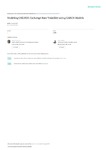| dc.description.abstract | this paper the generalized autoregressive conditional heteroscedastic models are applied in modeling exchange rate volatility of the USD/KES exchange rate using daily observations over the period starting 3rd January 2003 to 31st December 2015. The paper applies both symmetric and asymmetric models that capture most of the stylized facts about exchange rate returns such as volatility clustering and leverage effect. The performance of the symmetric GARCH (1, 1) and GARCH-M models as well as the asymmetric EGARCH (1, 1), GJR-GARCH (1, 1) and APARCH (1, 1) models with different residual distributions are applied to data. The most adequate models for estimating volatility of the exchange rates are the asymmetric APARCH model, GJR-GARCH model and EGARCH model with Student’s t-distribution.
Keywords: GARCH Models, Volatility clustering, forecasting volatility, Leverage effect, Value-at-Risk | en_US |

